
The Araceae are a family of monocotyledonous flowering plants in which flowers are borne on a type of inflorescence called a spadix. The spadix is usually accompanied by, and sometimes partially enclosed in, a spathe. Also known as the arum family, members are often colloquially known as aroids. This family of 140 genera and about 4,075 known species is most diverse in the New World tropics, although also distributed in the Old World tropics and northern temperate regions.

Philodendron is a large genus of flowering plants in the family Araceae. As of September 2015, the World Checklist of Selected Plant Families accepted 489 species; other sources accept different numbers. Regardless of number of species, the genus is the second-largest member of the family Araceae, after genus Anthurium. Taxonomically, the genus Philodendron is still poorly known, with many undescribed species. Many are grown as ornamental and indoor plants. The name derives from the Greek words philo- or "love, affection" and dendron or "tree". The generic name, Philodendron, is often used as the English name.

Alocasia is a genus of rhizomatous or tuberous, broad-leaved, perennial, flowering plants from the family Araceae. There are about 90 accepted species native to tropical and subtropical Asia and eastern Australia. Around the world, many growers widely cultivate a range of hybrids and cultivars as ornamentals.

Anthurium is a genus of about 1,000 species of flowering plants, the largest genus of the arum family, Araceae. General common names include anthurium, tailflower, flamingo flower, and laceleaf.

Zantedeschia is a genus of eight species of herbaceous, perennial, flowering plants in the family Araceae, native to southern Africa from South Africa north to Malawi. The genus has been introduced on all continents except Antarctica. Common names include arum lily for Z. aethiopica and calla and calla lily for Z. elliottiana and Z. rehmannii, although members of the genus are neither true lilies of Liliaceae, true Arums, nor true Callas. The colourful flowers and leaves of both species and cultivars are greatly valued and commonly grown as ornamental plants.
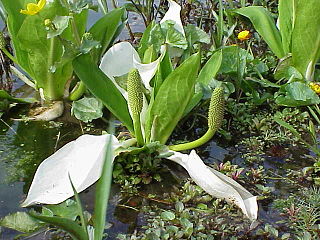
Lysichiton is a genus in the family Araceae. These plants are known commonly as skunk cabbage or less often as swamp lantern. The spelling Lysichitum is also found. The genus has two species, one found in north-east Asia, the other in north-west America.
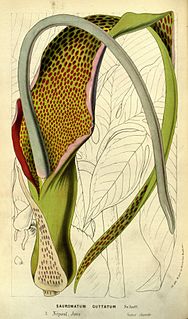
Sauromatum venosum is a species of plant in the arum family, Araceae. It is native to Asia and Africa, where it grows in forests and riparian meadows.
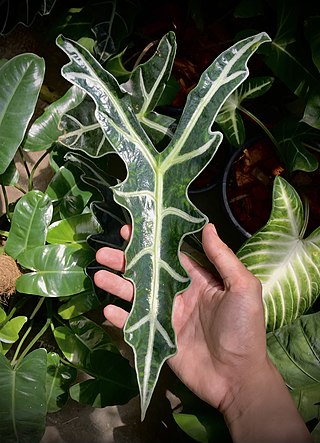
Alocasia sanderiana, commonly known as the kris plant or Sander's alocasia, is a plant in the family Araceae. It is endemic to Northern Mindanao in the Philippines, but is commonly grown as an ornamental plant worldwide. It is classified as critically endangered in the wild by the International Union for Conservation of Nature.
Ambrosina is a genus in the family Araceae that consists of only one species, Ambrosina bassii, and the only genus in the tribe Ambrosineae. This species is the smallest aroid in the Mediterranean, growing only to 8 cm tall. It is usually found growing in woodlands on north faces of hillsides and in humus soil that is covering limestone. It is distributed in Sardinia, Corsica, Sicily, southern mainland Italy, Tunisia, and Algeria.

Bucephalandra is a genus of flowering plants in the family Araceae. There are 30 species of Bucephalandra which have been discovered in Borneo and have been formally described by S.Y. Wong and P.C. Boyce. Most of the species are found in Borneo. Bucephalandra are usually found growing as dense mats over stones or rocks in streams or rivers in moist tropical forest.
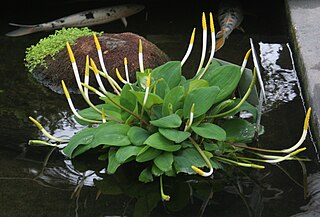
Orontium aquaticum, sometimes called golden-club, floating arum, never-wets or tawkin, is a species of flowering plants in the family Araceae. It is the single living species in the genus Orontium, which also contains several extinct species described from fossils. O. aquaticum is endemic to the eastern United States and is found growing in ponds, streams, and shallow lakes. It prefers an acidic environment. The leaves are pointed and oval with a water repellent surface. The inflorescence is most notable for having an extremely small almost indistinguishable sheath surrounding the spadix. Very early in the flowering this green sheath withers away leaving only the spadix.

Arisaema candidissimum is a species of flowering plant in the arum family (Araceae), originating in western China. Various English names have been given to the species, including Chinese cobra lily and Chinese jack-in-the-pulpit. The Chinese name is 白苞南星.
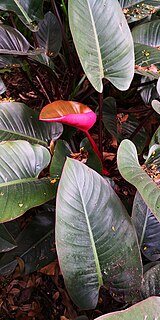
Philodendron erubescens, the blushing philodendron or red-leaf philodendron, is a species of flowering plant in the family Araceae, native to Colombia. It is a robust evergreen climber growing to 3–6 m (10–20 ft), with red stems and heart-shaped leaves up to 40 cm (16 in) in length. The flowers are deep red, fragrant spathes up to 15 cm (6 in) long, in summer and autumn. The specific epithet erubescens means "blushing".

Alocasia cucullata is a species of flowering plant in the arum family known by the common names Chinese taro, Chinese ape, Buddha's hand, and hooded dwarf elephant ear. It is kept as an ornamental plant.

Thaumatophyllum xanadu is a perennial plant belonging to the arum family Araceae and the genus Thaumatophyllum, formerly classified under the Meconostigma subgenus of Philodendron. This plant is native to Brazil, but is widely cultivated as a landscape plant in tropical, subtropical and warm temperate climates.
Alocasia robusta is a gigantic herb of the aroid family (Araceae) which is endemic to the island of Borneo. The plant is a rosette herb consisting of several leaves with a sagittate lamina or blade up to twelve feet long by eight feet wide, borne on very stout petioles or stalks up to 12 feet in length. More recently, Anthony Lamb of the Sabah Agricultural Department found and measured one individual with a lamina fifteen feet in length. The inflorescence is the spathe and spadix typical of the Arum family, with the spathe being a very dark blackish-purple color. This species was unknown to science prior to 1967. The plant is usually trunkless.
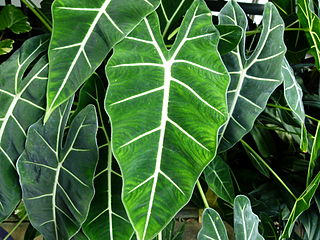
Alocasia micholitziana, commonly known as the green velvet taro or green velvet alocasia, is a plant in the family Araceae. It is endemic to the island of Luzon in the Philippines. It is commonly grown as an ornamental plant worldwide.
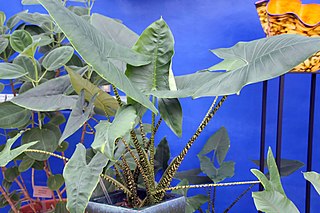
Alocasia zebrina, commonly known as the zebra plant or zebrina alocasia, is a plant in the family Araceae. It is endemic to the islands of Luzon, Mindanao, Leyte, Samar, Biliran, and Alabat in the Philippines. It is commonly grown as an ornamental plant worldwide. It is also locally known as gabing tigre in Tagalog. It is nationally listed as a threatened species and collection of A. zebrina from the wild is illegal in the Philippines.

Alocasia heterophylla is a plant in the family Araceae. It is endemic to the islands of Luzon, Mindanao, and Polillo in the Philippines.
Schismatoglottis prietoi is an aquatic and semi-aquatic plant species in the family Araceae. It is endemic to the Philippines in fast-flowing freshwater rivers in lowland forests. It is the only known species in the genus Schismatoglottis that can grow in a fully aquatic habitat. It is a small plant, growing only up to 2 to 8 cm tall. The pale green to green leaves are smooth and are around 3 to 4 cm long and 1 to 2 cm wide. They are oblong to elliptical in shape with sharply pointed tips and broadly wavy edges. It bears a single white flower that produces an unpleasant odor at the base, reminiscent of spoiled milk. It is colonial, growing in dense clumps through stolons.

















